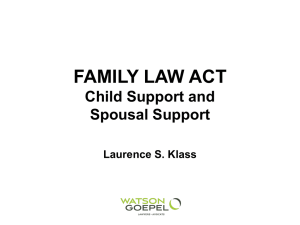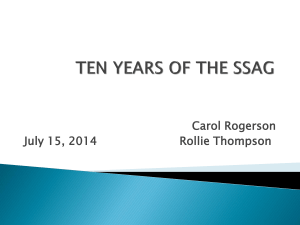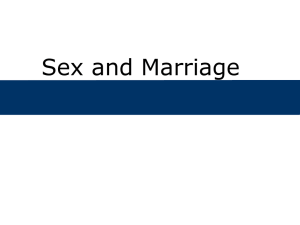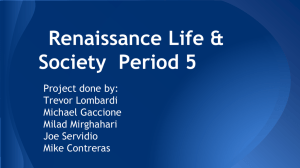Spousal Support Advisory Guidelines: A Draft
advertisement
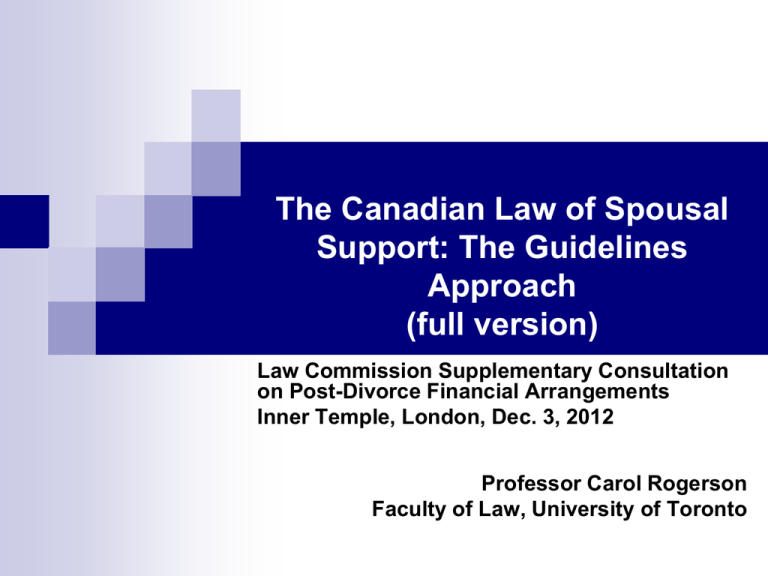
The Canadian Law of Spousal Support: The Guidelines Approach (full version) Law Commission Supplementary Consultation on Post-Divorce Financial Arrangements Inner Temple, London, Dec. 3, 2012 Professor Carol Rogerson Faculty of Law, University of Toronto Introduction Purpose: share with you experiences in Canada re one aspect of financial relief: law of spousal support Some discussion about substance of our law; grappling with basic principles like Law Commission More on method: advisory guidelines using “income sharing” formulas, SSAG Not suggesting that Canadian solutions appropriate for England specific content of our guidelines responsive to Canadian legal context but perhaps some general lessons re possibility of guidelines despite complex, challenging nature of this area of law emphasis: flexibility, practicality Theme: Rules vs. Discretion Average Justice vs. Individualized Justice In many family law systems (eg. Canada) see move towards more rule-based laws (Dewar) ensure fair results (consistency) efficient dispute resolution: certainty and predictability promote settlement, reduce costs and conflict Concern: rules can be too rigid; arbitrary and unfair (“cookie cutter justice”) but many different points on spectrum from discretion to rules balancing advantages and disadvantages of rules many ways of retaining scope for flexibility and discretion while providing structure and guidance Financial Relief: 3 Distinct Remedies 1. Matrimonial property division under provincial law; 10 different schemes all based on concept of marriage as a “partnership" presumptive equal division of a pool of marital assets; some discretion to depart (fairly “rule-based”) ability to defer sale of home; occupancy orders post-divorce 2. Child support divorcing couples under federal divorce law; others under prov. law (but laws the same) since 1997, legislated child support guidelines (fairly “rulebased”); court-based not agency based formulaic, percentage of payor income guidelines to determine basic amount of child support; then additional discretionary factors successful, wide support among lawyers, judges, public child support has priority over spousal support 3. Spousal Support legislation highly discretionary but now advisory guidelines (SSAG) to guide application SPOUSAL SUPPORT LAW Challenging and controversial Law complex, often uncertain Starting point of law reform in Canada (1980s) reject “pension for life” entitlement not based on mere status of marriage alone but what replaces traditional model? Statutory remedy, but little guidance; checklists of factors and objectives: eg. Divorce Act, 1985 recognize economic advantages/disadvantages apportion on-going costs of child care relieve economic hardship promote self-sufficiency Broad discretion to trial judges Leading SCC Cases Expanding basis for entitlement but increasing uncertainty: Pelech (1987) “clean break” emphasized promoting spousal independence short term transitional awards but found to be too harsh; inconsistent with statute Moge (1992) “compensatory” support focus on economic impact of marriage: economic advantages/ disadvantages; esp. women’s sacrifice of earning capacity because of child-rearing responsibilities how to implement? still too narrow? Bracklow (1999) “need” (“non-compensatory” support) support can also be based on “need” and interdependency basic needs? loss of marital standard of living? transitional or permanent? no clear answers no single model or theory/large role for discretion of trial judge Result: Spousal Support Law Too Uncertain and Unpredictable Potentially expansive basis for entitlement to spousal support but much uncertainty in application Different outcomes on similar facts depending on region and judge Some awards too low (underestimating economic impact of marriage and children), some too high (returning to pension for life) For lawyers: hard to advise clients and settle cases Many women not claiming spousal support even though entitled Growing dissatisfaction with current state of law SPOUSAL SUPPORT ADVISORY GUIDELINES (SSAG) PROJECT Project starts in 2001 Justice Canada, Profs Rogerson and Thompson, Family Law Advisory Group Explore possibility of developing advisory guidelines for spousal support based on income-sharing: not legislated; true “guidelines” practical tool Impetus: dissatisfaction with current state of law but also sense of dominant patterns emerging in typical cases positive experience with income-sharing guidelines for child support; computer soft-ware generating household net income comparisons some lawyers and judges creating own informal formulas American Law Institute (ALI): sophisticated model DEVELOPMENT OF THE SSAG Work with advisory group: identify outcomes, dominant patterns in typical cases develop income sharing formulas to capture those results reflecting current law: guidelines built “from the ground up” “Draft Proposal” January 2005 Wide consultation and feedback, judges and lawyers Final Version, July 2008 SSAG web site at University of Toronto: http://www.law.utoronto.ca/faculty/rogerson/ssag.html Rogerson & Thompson, “The Canadian Experiment with Spousal Support Guidelines” (2011) 45 Family Law Quarterly 241 (also on SSAG web site) OVERVIEW OF THE SSAG Not legislated; informal and advisory (a practical “tool”) Intended to reflect current law not change it use not mandatory; true “guidelines” focus on dominant patterns not outliers pragmatic rather than theoretical Formulas to assist in determining amount and duration of support after entitlement is established under statute Flexible scheme; not “rigid” (but also complex) not a single formula: two basic formulas and several other variants formulas generate ranges rather than precise amounts and durations; scope to respond to facts of individual cases starting point in typical cases: then address exceptions initial determinations under SSAG will often require on-going variation in response to changing incomes, repartnering, second families, etc. SPOUSAL SUPPORT ADVISORY GUIDELINES: RESPONSES Initial reactions mixed: concerns with illegitimacy and “cookie cutter justice” to complex, fact-specific issues initial reactions often based on assumptions not actual nature of scheme (assume more “rigid” scheme) Over time have become widely accepted and used by lawyers and judges across country Use facilitated by development of computer software Lawyers: very useful in shaping client expectations and providing structure for negotiations Strong appellate court endorsement in three provinces (B.C., N.B., Ont.): useful tool legal status analogous to compilation of precedent don’t eliminate need for an individualized analysis; “starting point” or “litmus test” THE SSAG FORMULAS Formulas work off income disparity between parties; are based on income-sharing But also incorporate other factors: length of marriage presence of minor children age of parties Two basic formulas the without child support formula (“merger over time”) the with child support formula (“parental partnership”) The Without Child Support Formula “Merger over Time”: amount and duration both increase with length of marriage Amount: Range 1.5 to 2 % of the difference between the spouses’ gross incomes (the gross income difference) for each year of marriage up to a maximum of range of 37.5 to 50% at 25 years plus. Duration: Range ½ to 1 year for each year of marriage. Indefinite (no fixed time limit) if the marriage is 20 years or longer Without Child Support Examples John earns $70,000 (£44,000); Mary $30,000 (£19,000) Gross income difference = $40,000 (£25,000) If marriage 20 years: Applicable percentage: (1.5 to 2% for each year) =30 to 40% Amount of ss: $12,000 to $16,000 annually (£7,500 to £10,000) or $1000 to $1333 monthly (£625 - £833) Duration: indefinite because marriage 20 yrs (subject to subsequent review and variation) If marriage 10 years: Applicable percentage: 15 to 20% Amount of ss: $6,000 to $8,000 annually (£3,750 to £5,000) or $500 to $666 monthly (£312 to £416) Duration: (1/2 to 1 yr for each yr of marrriage) = 5 to 10 years Can use formula outcomes to “front-end load” or create lump sums The With Child Support Formula “Parental Partnership”: focus on past and on-going childcare Amount: Recognizes priority to child support Does not vary with length of marriage Divides pool of net income after parties have met their child support obligations and paid taxes so that after payment of spousal support recipient is left with 40 to 46% of that pool Requires computer software for calculations Duration: Orders usually indefinite; duration worked out through review and variation Durational limits to be implemented on variation and review Combination of length of marriage and ages of children (shorter marriages) With Child Support Example 1 Bob earns $70,000 (£44,000) Alice earns zero 11 yr marriage 2 children aged 8 and 10 with Alice Child support: table for 2 children $1037 (£652) per month Spousal support range: $879 to $1,192 (£552 to £750) per month; Will leave Alice with between 51 to 56% of net household income (including child support) Duration: indefinite; expected duration between 5.5 to 11 years to be determined on variation/review; Alice will be expected to train and find employment in this period With Child Support Example 2 If Alice finds employment and now earns $30,000 (£19,000) how will the spousal support change? Spousal support range: zero to $199 (£125) per month; Will leave Alice with between 55 to 57% of net household income (including child support) EXCEPTIONS Compelling financial circumstances in interim period Debt payment Prior support obligations: support for prior child or prior spouse Illness and disability Compensatory exception in shorter marriages: disproportionate loss/advantage Payor incomes over $350,000 and under $20,000 Post-separation income increases Remarriage, repartnering and second families Assessment of the SSAG Formal evaluation (2012) plus evidence from consultations and case law: largely positive Widely used; provide clearer starting points and more structure; greater predictability and certainty; less conflict Duration more difficult than amount New focus on income as a major issue (actual, imputed) But complex: long document; need software; formulas not rigid and don’t provide clear answers (advantage and disadvantage) Main problem: unsophisticated use; tendency to turn SSAG into default rules; ignore the exceptions; choose midpoint of range by default; but easing over time with use and education Also unclear status: advisory Conclusion Lessons to be drawn from Canadian experience with SSAG: Spousal support amenable to guidelines regime provided guidelines sufficiently flexible and sophisticated Advisory guidelines can accommodate multiple objectives in a practical way Advisory guidelines can resolve large numbers of typical cases and offer structure that informs resolution of more difficult cases Greater consistency and predictability of outcomes leads to greater fairness and legitimacy for the substantive remedy



